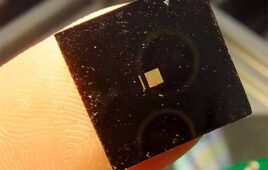
[Image from the Wyss Institute]
The researchers previously showed that a soft robotic exosuit could lower energy expenditures in healthy people who need to carry things on their backs, but the new research shows that it can also decrease metabolic rates through exosuit assistance.
The research team offboarded the actuation, electronics and battery units from the exosuit in order to specifically calculate how the exosuit impacted a user’s joints. All that was left was the light wearable textiles and pulling cables of the exosuit.
Seven participants walked 1.5 meters per second on a treadmill with the remaining exosuit parts under 1 unpowered and 4 powered conditions. The peak moment applied at the ankle joint varied from 10 to 38%, which is the same as an applied force of 18.7 to 75% of body weight.
“In a test group of seven healthy wearers, we clearly saw that the more assistance provided to the ankle joints, the more energy the wearers could save with a maximum reduction of almost 23% compared to walking with the exosuit powered-off,” said Conor Walsh, who led the research team and is a Wyss Institute Core Faculty member, John L. Loeb associate professor of engineering and applied sciences at the Harvard John A. Paulson School of Engineering and Applied Sciences (SEAS) and founder of the Harvard Biodesign Lab.
Those who wore the exosuits had significantly adapted their gait as the levels of assistance increased. The ankle joints saw the most significant changes, as well as the hips with the help of straps stretching from the back of the lower legs to the front of the hip.
Net metabolic rates continually decreased with exosuit assistance. There was also a reduction of 22.83 ± 3.17% in the metabolic rate of walking relative to the powered-off condition.
“To our knowledge, this is the highest relative reduction in energy expenditure observed to date with a tethered exoskeleton or exosuit,” said Walsh in a Wyss Institute news release.
“Other studies had reported that there can be an energy transfer between the ankle and other joints. However, by having a textile couple the ankle and hip with our soft exosuit, may have amplified this effect, contributing to the considerable energy savings we found,” said Brendan Quinlivan, one of the first authors on the study.
The researchers will further study the effects of soft exosuits using the items they removed to have a full understanding of how the suits affect energy consumption.
Past studies by the Wyss Institute showed that lower limb joints had an overall energy savings of about 7% when carrying a load that was 30% of their body weight using the soft exosuit.
The study was supported by the Wyss Institute of Biologically Inspired Engineering, the Harvard John A. Paulson School of Engineering and Applied Sciences, the Defense Advanced Research Projects Agency’s Warrior Web Program, the National Science Foundation, a Samsung scholarship, the São Paulo Research Foundation and the Robert Bosch Stiftung. The research is published online in the Science Robotics journal.
[Want to stay more on top of MDO content? Subscribe to our weekly e-newsletter.]




